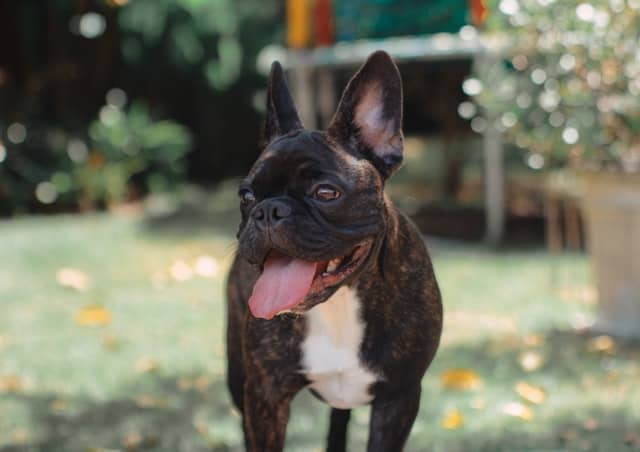
A Frenchie is adorable and loving. But just like any other pet, it is part of your responsibility to ensure that it is well taken care of. You need to treat it like your own child. This type of dog has unique characteristics, no more so than it’s nose, teeth and mouth!
So as the owner, you have to familiarize yourself with all these.
If you are thinking about getting a French bulldog for a pet, or perhaps you already have one and you are curious about how you could keep it healthy, especially when it comes to its teeth, this article is for you.
But to better understand any problems with teeth that our French Bulldog might have, I want to start by talking about the teeth that are in all dog’s mouths..
What are the different types of teeth found in a dog’s mouth?
There are 4 sets of teeth found in a dog’s mouth and each type of tooth serves a very specific purpose.
Incisors:
These are the teeth at the very front of a dog’s mouth- there are 12 of them 6 at the top and 6 of the bottom.
These are the very small flat teeth at the front of the mouth. These teeth are excellent at scraping or gnawing.
Back then they would have been used most often for scraping the last pieces of flesh off a bone but I am most used to seeing my dog’s use these teeth to scrape or gnaw at their coats as they clean themselves.
Canines
These are a dog’s fangs- the four large curved teeth at the side of a dog’s mouth. Two of these are found in the top of the mouth and two of these are found in the bottom of the mouth.
The two top canines are far bigger than the bottom two.
The dog will use their canine teeth in order to puncture their prey or to hold on to it as tightly as possible.
In my experience, these are the teeth that my dog will use to “lock” the sleeve of my coat as we are playing out on a walk.
Premolars
These teeth are positioned just behind the canine teeth. There are sixteen of them in a dog’s mouth: eight on top and eight on the bottom.
They are used for tearing and chewing.
Just watch your dog as they next sit down with a stick. The stick is positioned in the side of their mouth and it is the premolars that do all the work as the stick is broken into tiny pieces and then spat out! (Add video of Sylvie and a stick.)
Molars
Another heavyweight type of tooth made to crush and grind- you can see them in action the next time that you give your dog a bone.
These are the only teeth where there is not the same number on the top and bottom.
At the top there are six molars and on the bottom there are only four.
The power generated by this action is phenomenal and again if you think about your dog’s bone, you will hear that rather sickening noise as these teeth crush the bone into smaller pieces.
And on that note, let’s move on and think about a Frenchie’s mouth.
The Structure of a French Bulldog’s mouth
French Bulldogs are more prone to dental problems for two reasons.
- They are brachycephalic (or short nosed.)
- They have an underbite- when the lower jaw comes out further than the upper jaw.
All dogs, large or small, pedigree or mixed breed have forty two teeth.
If you have a short nose breed all of these teeth need to fit into a smaller space and if your underbite is too severe, the teeth in the top jaw and the teeth on the bottom jaw will not fit together perfectly.
The potential for a French Bulldog to have problems with their teeth is much more likely than with other breeds.
Now, this is not the case for all French Bulldogs.
I don’t want to fill you with a sense of dread that your Frenchie is certain to suffer some kind of teeth problem during their life. It is by no means a certainty.
But for structural reasons, a French Bulldog is vulnerable to dental problems unless they are carefully managed.
The Blessing of The Underbite
A blessing, you what?
I know that in the section above I have just expressed concern about a French Bulldog’s underbite- but this structure does have an upside.
On the positive side, an underbite is part of a French Bulldog’s strangely adorable looks and it is deemed to be such a key characteristic that it is included in the breed standard for the Frenchie.
The breed standard is a description of attributes that any pedigree breed of dog must have in order to compete and do well in dog shows.
The French Bulldog breed standard for the American Kennel Club (AKC) can be read here and the breed standard for the British Kennel Club (a.k.a. The Kennel Club) is here.
Occlusion vs Malocclusion
In the perfect canine world, the teeth in the upper and lower jaws fit together perfectly. Occlusion is the scientific term for the way that teeth align with each other. A normal occlusion is when there is perfect alignment.
Normal occlusion only happens with an overbite- when the teeth in the upper jaw hang over the teeth in the lower jaw by a fraction.
The jaw is like a jigsaw puzzle with spaces for each tooth. For instance the lower canines fit just in the gap in front of the upper canines and the triangle shaped premolars (behind the canines) fit between one another.
In a normal occlusion, there aren’t any teeth that are resting on top of another tooth or any teeth and there aren’t any teeth resting painfully against any gums.
In contrast, teeth that are incorrectly aligned are labelled as malocclusions and a class three malocclusion is called an underbite.
The Biggest Problems of an Underbite
As I intimated above, the overwhelming majority of French Bulldog’s have an underbite but the severity of the malocclusion will differ between individual dogs.
The two biggest teeth problems that result from a French Bulldog’s facial structure, are:
- Loose or crooked teeth
- Worn teeth
Loose teeth
Because French Bulldog’s have a short nose and there are so many teeth to fit into such a tight space, they are more likely than other breeds of dogs to have loose or crooked teeth.
Worn teeth
As a Frenchie will probably have a class two malocclusion or underbite, their teeth do not perfectly align.
When the dog’s mouth is closed, some of the teeth will be resting on top of each other and not in any gaps in the jaw.
Over time these teeth could wear each other down particularly if your dog is a “chewer” and likes nothing better than to gnaw away at the favourite toy or a stick.
Depending on the severity, your dog’s underbite might cause your dog no issues in its lifetime or it might call for specialist and expensive dental surgery (or anything in between.)
Weird facts about dog’s teeth
Here’s a few weird facts about dogs and their teeth.
#1. 80% of all dogs over the age of three have an active dental disease
#2. There are about 600 different types of bacteria in a dog’s mouth, which sounds a bit frightening until you learn that there are about 615 in a human mouth….
#3. Dogs are five times more likely to have gum disease than humans because the pH level in their mouths is more alkaline than humans and plaque forms faster in an alkali.
Most common dental diseases in French Bulldogs
In truth, all of the dental problems that I describe below are common to all dogs, not just French Bulldogs.
But, as we discussed above, because of their unique facial structure, Frenchies are more likely than other breeds to broken, worn, loose or misaligned teeth.
And this inherent weakness must make French Bulldogs more at risk of the five big dental “no-no’s” than other breeds.
What are these “no- no’s”? Plague, tartar, gum and periodontal disease and abscesses…
[1] Plaque and Tartar
If you thought that these two words meant almost the same thing, you were wrong!
Plaque is a soft film that starts to coat a dog’s mouth soon after they have eaten. This film is a mixture of saliva, bits of food and bacteria.
Whereas tartar is the yellow or brown “varnish” that we see on our dogs teeth, most often at the top or bottom of the tooth by the gums.
But here’s the thing..
Tartar is a bit like an iceberg because just as iceberg exists above and below the surface of the sea, tartar forms above and below the gum line.
Now some vets believe that tartar takes only 24 hours to form, whereas other vets believe that it takes about three days.
Plaque morphs into tartar because of mineral salts in a dog’s mouth.
Tartar is a bit like a dried patch of salt in the mouth because it has a rough and porous surface which is bad news because tartar acts like a magnet and attracts more bacteria.
And the potential dangers start to multiply as the teeth and gums come under attack from the increasingly dangerous bacteria- which can also go on to poison other organs if it gets into the bloodstream.
Unlike a patch of dried salt, tartar is rock hard and much more difficult to remove.
Is there anybody else, who after reading that, wants to run to the bathroom and clean their own teeth?!
[2] Gum disease
Gum disease is caused by a buildup of plaque and tartar.
There are two main forms of gum disease in a dog- the mild form is called gingivitis and the severe form is periodontal disease.
Gingivitis affects the gums- they can become an angrier shade of red, become swollen and even bleed.
A saving grace of mild form of gingivitis is that since it only attacks soft tissue, the teeth and their supporting structures aren’t too badly damaged.
[3] Periodontal disease
But all this changes with periodontal disease.
This is a case of untreated gingivitis that is so severe that the teeth and their supporting structures are in very real danger.
When the teeth are weakened, they can crack or split or even come loose.
[4] Abscesses
Well this unsavoury section is nearly over but before we finish talking about the most common dental diseases, I need to tell you about abscesses.
A few friends of mine have had abscesses and they told me that the pain of having one is simply unbelievable.
Painkillers don’t touch the pain, which is not just in your mouth but ricocheting around in your head.
It leaves you so helpless that you are thinking the most irrational thoughts, such as “I would chop my head off in order to stop the pain.”
Now imagine how agonising they must be for our dogs?
An abscess is an infection around the root of a tooth.
We have spoken at length about the all out war that bacteria wages on our mouths and an abscess is created when bacteria enters a cracked or damaged tooth.
To me, the most alarming fact about any of the dental diseases described below is that if they aren’t dealt with, they can cause other organs in the body, such as the heart, liver or kidney, to fail.
Scary right?
Has my Frenchie got gum disease?
So at this point we are all thinking that we need to be more vigilant and to do more to protect our dog’s mouths, right?
And the earlier that we can take action the better, I guess?
So we need to put on our x-ray specs and find that gingivitis before it turns into periodontal disease.
But here’s the rub…
It is very hard to catch.
It is hard to spot the early stages of gingivitis because they will be no visible signs in our dog’s mouth.
Your best chance of catching this disease in the early stages is by noticing changes in your dog’s behaviour.
And there are 11 odd behaviours that you should be on the lookout for and my top 5 are:
- Odd eating behaviours such as eating on one side of the mouth only.
- Not wanting their head to be touched
- Blood in the water bowl or on “chew” toys
- Your dog makes noises when they eat
- Bad breath
Drooling, Saliva and Tooth Decay
Now at this point, some of you Frenchie owners might be joining the dots together in your mind and worrying about drooling.
After all, French Bulldogs are more prone to drooling than other breeds of dogs.
But let’s keep it short and sweet.
Although drooling in and of itself can be a symptom of some serious issues (such as heat stroke or anxiety) as well as being an unsightly habit, drooling in no way damages your French Bulldog’s teeth.
In fact one of the key roles of saliva is to protect teeth.
How many teeth should my French Bulldog have as a puppy and an adult?
Just like humans, French bulldogs are not born with teeth. The milk teeth won’t come out until they are about two weeks old. In general, a puppy should have a total of 28 teeth, while an adult has 42.
When should they have adult teeth?
The baby teeth of a Frenchie don’t stay very long. As soon as it reaches the age of 12 weeks or 3 months, the adult teeth will start coming through. Your dog will have a total of 42 adult teeth, and you can expect them to be complete at 7 to 8 months.
What should you do if their milk teeth don’t fall out?
There are cases wherein the milk teeth don’t fall out on their own. And if they stay that way for a long time, some problems may arise. There may be abnormal jaw bone growth as well as enamel deterioration, and both of these issues are difficult, or worse, cannot be corrected.
How can you keep a Frenchie’s teeth clean and healthy?
Just like human beings, it is important that you, as the owner, ensure that your dog’s dental health is all good. You have to keep its teeth clean and healthy at all times so as to avoid the development of oral diseases. You need to take it to your veterinarian too, at least, once a year for dental cleaning.
There are various things that you can do at home to take good care of your Frenchie’s teeth. Here are some of them:
Brush Your Dog’s Teeth
Brushing those teeth is probably the easiest and most effective way for you to take care of your pet’s dental health. Doing so will help prevent dental diseases as well as tooth decay.
At first, you might have a problem brushing your French bulldog’s teeth because it is not accustomed to the sensation. But with proper training, you won’t have any more issue with this sooner or later.
- How To Introduce A French Bulldog To A Cat
Furthermore, you have to use the right toothbrush and toothpaste. Do not use human toothpaste because it contains some ingredients, like fluoride, that may hurt your dog. You need to get something that is really labeled for dog use.
Serve Only Healthy Food
Another great way to promote healthy teeth for your dog is to feed it with only healthy food. High-quality meals will provide your pet with the nourishment that it needs so its teeth will stay strong and healthy.
Avoid giving poor-quality foods to your French bulldog because this will only ruin its teeth and may also result in more serious oral problems.
Give Some Dental Chews
Have you ever heard of dental chews before? These are usually given to dogs to clean its teeth as what brushing would do. In fact, these are considered as a great treat. As your Frenchie chews on them, food particles that got stuck in between the teeth will be removed. They help get rid of plaque and tartar as well.
How should you deal with tartar and plaque?
Tartar and plaque buildup on your Frenchie’s teeth will certainly lead to serious dental issues. Therefore, you have to deal with them as early as possible. Here are things that you can do:
Brush Its Teeth Regularly
Like what we have mentioned above, brushing teeth is the best thing that you can do to avoid tartar and plaque problems. As much as possible, start training your pet on this as early as its puppy stage.
Use a Dental Water Additive
In case your dog is reluctant in brushing its teeth, you can use a dental water additive instead. You just have to add the solution to its drinking water. It will help reduce the bacteria that are present in your pup’s mouth and it will help freshen its breath too.
Utilize Dental Wipes
Using dental wipe is another excellent option if you are having difficulty brushing your poochie’s teeth. You simply have to use the sheets to wipe its teeth and remove the tartar or plaque.





